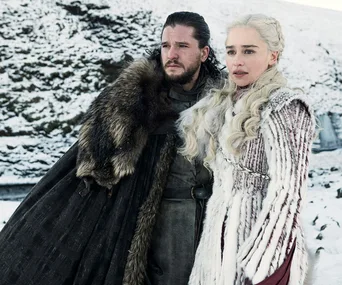Seeing one of your dragons killed in action may be the pinnacle of pet loss – our condolences, Dany, #RIPRhaegal – but saying goodbye to your beloved pooch without as much as a “now that’s a good boy” and a pat on the head? What’s that all about, Jon Snow?
That’s what fans of Game Of Thrones were fixated on when they weren’t fretting over coffee cups, lost love, lost heads and odd character turns.
They were a bit concerned that Jon’s farewell to his loyal direwolf Ghost was a bit, um, frosty, even for the North.
After the Battle Of Winterfell ended, Free Folk warrior Tormund Giantsbane decides to return to his homeland past Castle Black and has a final chat with Jon about it. Jon looks over to Ghost and tells Tormund, “That’s where belongs, too. A direwolf has no place in the South.” At this point, Ghost’s look says it all – “You’re gonna leave me, aren’t cha?”
Then, Jon trades parting thoughts with Gilly and best pal Sam before walking away, pausing to have one last glance at Ghost. Jon seems about to cry, but he doesn’t. He just looks down, and Ghost, too, looks down. Neither moves toward each other.
Why?
As episode director David Nutter explained to Insider, it was all about simplifying the filming process, and, in fact, viewers were lucky to even see Ghost at all.
“Well, the good thing was he wasn’t right next to the actors and so forth, so there wasn’t any issues with green screen or situations where we’re dealing with any kind of rotoscoping,” David said. “So basically it was just reminding Kit [Harington] about the direwolves and discussing them. He knew the importance of the direwolf very well and how close [Jon] was to him. [Harington] understood exactly where to play that and where to take it.”
But when asked if CGI were an issue, David told The New York Times, “Very much so. It’s all about how to balance that all out, and making sure it’s done properly, and reminding you of the characters and what’s at stake and what’s happening at any particular moment. Jon saying goodbye to the direwolf was so very powerful and rich because of the actors. They’ve spent many years doing this, and it’s the culmination of their characters in some respects, so it’s manipulating how much you want to give them. All that kind of stuff, we play with. It’s about finding the best idea and being able to rally around whatever that idea is.”
The idea of a “best idea” reminds us of the other living direwolf in Westeros – Nymeria – and though CGI may be the practical reason both creatures got a distant send-off, there are interesting parallels to their goodbyes.
Ghost was the outcast of his litter. An albino puppy, Jon Snow, a bastard Stark son himself, took him in. The two misfits, one pure of heart and the other pure as snow, headed to the Wall together. Ghost remained a loyal companion, the way Jon was steadfast to his mates and to the side of good.
Just like Jon, Ghost did his thing quietly, efficiently, and without seeking glory. So when Jon leaves him to the North, he accepts his fate, just like Jon accepts his.
Meanwhile, Nymeria was always a fierce young pup, suited to her master, Arya Stark. When Joffrey fights Arya in season one, Nymeria bites him, setting off the chain of events that leads to Sansa’s direwolf Lady being killed on Cersei’s orders.
Fearing for Nymeria’s own safety, Arya shoos her away, urging her to escape into the woods.
Only in the second episode of season seven do we see Nymeria again. This time, as Arya, a faceless assassin in training, is being chased by wolves on her way back to Winterfell, she sees Nymeria leading the pack. They recognise each other, but when Arya encourages Nymeria to come with her, she refuses.
Like her human, Nymeria has become an independent warrior and won’t submit to being a lady for anyone. Arya gets it, and though sad, respects Nymeria’s choice. In return, Nymeria literally calls off the dogs to protect Arya and offer her safe passage home.
So yes, their farewell was just as CGI-distant as Jon’s with Ghost, but just as emotionally resonant.
The folks behind Game Of Thrones may have budget concerns in the real world, but their storytelling logic remains poetic and sound.

